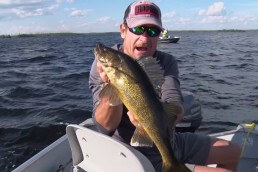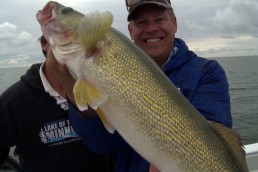Opportunities for Catching Walleyes in Indiana
SHARE THIS POST
Every year, anglers travel from Indiana to the Northland to catch walleyes. Minnesota, Wisconsin, Michigan and the provinces of Canada certainly have many lakes and rivers that boast populations of this tasty fish, but angling opportunities also exist in the Hoosier state.
Stocking Indiana waters
Each spring, Indiana biologists collect walleye eggs from Brookville Reservoir in southern Indiana. They may collect up to 30 million eggs, with stocking rates of about 17 million walleye fry, 1 million 1 to 2-inch fingerlings and 60 thousand saugeye fingerlings. The saugeye is a hybrid cross of a walleye and a sauger, another member of the perch family.
The following locations are stocked with walleyes (counties in parentheses): Bass Lake (Starke), Brookville Reservoir (Franklin and Union), Cagles Mill Reservoir (Putnam and Owen), Clear Lake (Steuben), Crooked Lake (Steuben), Lake George (Steuben), Eagle Creek Reservoir (Marion), Kokomo Reservoir (Howard), Lake Maxinkuckee (Marshall), Lake of the Woods (Marshall), Monroe Reservoir (Brown and Monroe), Patoka Reservoir (Orange, Dubois and Crawford), Pike Lake (Kosciusko), Pretty Lake (La Grange), Sylvan (Noble), Wall Lake (La Grange) and Winona (Kosciusko).
Wolf Lake (Lake) is stocked yearly by a local club, Perch America. Their outstanding efforts have resulted in a good fishery in Northwest Indiana.
Rivers and tailwaters below dams
Rivers also provide walleye fishing opportunities. Try the St. Joseph River, Ohio River, Kankakee River and the Tippecanoe. In fact, the Indiana state record walleye is shared by the Tippecanoe and Kankakee Rivers at 14 pounds, 4 ounces.
Tailwaters below the dams at Monroe Reservoir, Salamonie Reservoir, Mississinewa Reservoir, Cagles Mill Reservoir and Lake Freeman can provide good walleye fishing—especially in the spring months.
Southern Lake Michigan is also home to a small walleye population. Discharges into the Big Lake and the mouths of tributary streams like Burns Ditch in Portage and Trail Creek in Michigan City are areas that do produce an occasional fish up to 10 pounds or more.
Locations
Walleyes usually prefer some type of hard bottom. Structure of the lake plays an important role throughout the year. Walleyes prefer rock or gravel areas, drop-offs and shoreline-related points, underwater humps, sand bars and deep-water edges of weed beds. In reservoirs, areas of standing timber often hold walleyes. Populations of walleyes can also roam the deep-water basins, feeding on schools of baitfish.
In general, walleyes like deeper water during the daylight hours and move to the shallow flats to feed under low-light conditions where they are often caught in 10 feet of water or less.
Are you enjoying this post?
You can be among the first to get the latest info on where to go, what to use and how to use it!
In rivers and tailwaters, look for slack-water eddies and deep holes. Current seams can also be important.
Presentations
In our state, most walleye anglers rely on a quality monofilament or fluorocarbon line in 6 or 8-pound test. Heavier line may be used when fishing snag-infested waters with rocks, logs or timber, but lighter line will often give you better results—especially when fishing in clear water.
The bulk of the walleye diet consists of smaller baitfish. However, like all fish, they are opportunistic feeders. They will devour crayfish, may flies and other insects, and bluegills when they are the most abundant and easy prey.
Shad or minnow-imitating crankbaits like the old, original Rapala and Shad Rap are proven fish catchers. Most times, troll crankbaits close to the bottom. But, watch your electronics for suspended fish.
Using live bait is a staple for walleyes. Live-bait rigs like the Lindy Rig can produce when nothing else will. Live nightcrawlers, minnows and leeches are most popular.
One of the most popular presentations is a jig and live bait. Minnows, crawlers and leeches are most often used with the proper weight jig, considering the depth of water, wind and any current.
Jigs and artificial lures also account for many walleyes. Jigs and Mr. Twisters are a tried-and-true presentation. Berkley Power bait and Gulp! Alive! Minnows in the 3 and 4-inch sizes are preferred by many anglers today.
As you can see, several opportunities for walleyes exist here in Indiana. One location is probably near you, so why not give it a try!
MWO
SHARE THIS POST
Did you enjoy this post?
You can be among the first to get the latest info on where to go, what to use and how to use it!
Bill Takacs
Bill Takacs of Hammond, Ind., has been writing for MidWest Outdoors regularly since 1975, and has been published in several state, regional and national publications. He fishes for virtually every freshwater fish from panfish to muskies, with the exceptions of sturgeon and alligator gar.



